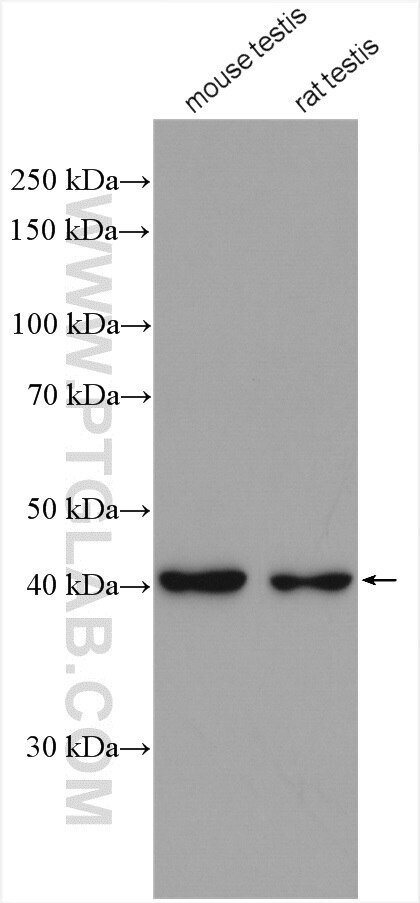Tested Applications
| Positive WB detected in | mouse testis tissue, rat testis tissue |
Recommended dilution
| Application | Dilution |
|---|---|
| Western Blot (WB) | WB : 1:500-1:2000 |
| It is recommended that this reagent should be titrated in each testing system to obtain optimal results. | |
| Sample-dependent, Check data in validation data gallery. | |
Published Applications
| WB | See 2 publications below |
| IF | See 1 publications below |
| CoIP | See 1 publications below |
Product Information
16992-1-AP targets ACTRT2 in WB, IF, CoIP, ELISA applications and shows reactivity with human, mouse, rat samples.
| Tested Reactivity | human, mouse, rat |
| Cited Reactivity | human, mouse |
| Host / Isotype | Rabbit / IgG |
| Class | Polyclonal |
| Type | Antibody |
| Immunogen | ACTRT2 fusion protein Ag10597 Predict reactive species |
| Full Name | actin-related protein T2 |
| Calculated Molecular Weight | 376 aa, 42 kDa |
| Observed Molecular Weight | 40-42 kDa |
| GenBank Accession Number | BC029499 |
| Gene Symbol | ACTRT2 |
| Gene ID (NCBI) | 140625 |
| RRID | AB_2878338 |
| Conjugate | Unconjugated |
| Form | Liquid |
| Purification Method | Antigen affinity purification |
| UNIPROT ID | Q8TDY3 |
| Storage Buffer | PBS with 0.02% sodium azide and 50% glycerol , pH 7.3 |
| Storage Conditions | Store at -20°C. Stable for one year after shipment. Aliquoting is unnecessary for -20oC storage. 20ul sizes contain 0.1% BSA. |
Protocols
| Product Specific Protocols | |
|---|---|
| WB protocol for ACTRT2 antibody 16992-1-AP | Download protocol |
| Standard Protocols | |
|---|---|
| Click here to view our Standard Protocols |
Publications
| Species | Application | Title |
|---|---|---|
Hum Reprod Deletion of ACTRT1 is associated with male infertility as sperm acrosomal ultrastructural defects and fertilization failure in human | ||
Development Loss of perinuclear theca ACTRT1 causes acrosome detachment and severe male subfertility in mice. | ||
Cell Rep The perinuclear theca protein Calicin helps shape the sperm head and maintain the nuclear structure in mice. |



